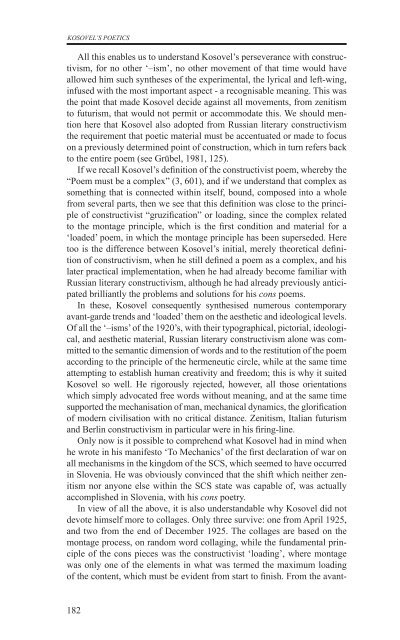razprave (pdf) - Društvo za primerjalno književnost - ZRC SAZU
razprave (pdf) - Društvo za primerjalno književnost - ZRC SAZU
razprave (pdf) - Društvo za primerjalno književnost - ZRC SAZU
- No tags were found...
You also want an ePaper? Increase the reach of your titles
YUMPU automatically turns print PDFs into web optimized ePapers that Google loves.
KOSOVEL’s poeticsAll this enables us to understand Kosovel’s perseverance with constructivism,for no other ‘–ism’, no other movement of that time would haveallowed him such syntheses of the experimental, the lyrical and left-wing,infused with the most important aspect - a recognisable meaning. This wasthe point that made Kosovel decide against all movements, from zenitismto futurism, that would not permit or accommodate this. We should mentionhere that Kosovel also adopted from Russian literary constructivismthe requirement that poetic material must be accentuated or made to focuson a previously determined point of construction, which in turn refers backto the entire poem (see Grübel, 1981, 125).If we recall Kosovel’s definition of the constructivist poem, whereby the“Poem must be a complex” (3, 601), and if we understand that complex assomething that is connected within itself, bound, composed into a wholefrom several parts, then we see that this definition was close to the principleof constructivist “gruzification” or loading, since the complex relatedto the montage principle, which is the first condition and material for a‘loaded’ poem, in which the montage principle has been superseded. Heretoo is the difference between Kosovel’s initial, merely theoretical definitionof constructivism, when he still defined a poem as a complex, and hislater practical implementation, when he had already become familiar withRussian literary constructivism, although he had already previously anticipatedbrilliantly the problems and solutions for his cons poems.In these, Kosovel consequently synthesised numerous contemporaryavant-garde trends and ‘loaded’ them on the aesthetic and ideological levels.Of all the ‘–isms’ of the 1920’s, with their typographical, pictorial, ideological,and aesthetic material, Russian literary constructivism alone was committedto the semantic dimension of words and to the restitution of the poemaccording to the principle of the hermeneutic circle, while at the same timeattempting to establish human creativity and freedom; this is why it suitedKosovel so well. He rigorously rejected, however, all those orientationswhich simply advocated free words without meaning, and at the same timesupported the mechanisation of man, mechanical dynamics, the glorificationof modern civilisation with no critical distance. Zenitism, Italian futurismand Berlin constructivism in particular were in his firing-line.Only now is it possible to comprehend what Kosovel had in mind whenhe wrote in his manifesto ‘To Mechanics’ of the first declaration of war onall mechanisms in the kingdom of the SCS, which seemed to have occurredin Slovenia. He was obviously convinced that the shift which neither zenitismnor anyone else within the SCS state was capable of, was actuallyaccomplished in Slovenia, with his cons poetry.In view of all the above, it is also understandable why Kosovel did notdevote himself more to collages. Only three survive: one from April 1925,and two from the end of December 1925. The collages are based on themontage process, on random word collaging, while the fundamental principleof the cons pieces was the constructivist ‘loading’, where montagewas only one of the elements in what was termed the maximum loadingof the content, which must be evident from start to finish. From the avant-182
















